We should also point out that the “greatness of the kingdom under the whole heaven” (Dan 7:27) that will one day “fill the whole earth” (Dan 2:35) is shown in Dan 2:44 to come “in the days of these kings.” This is very significant, because at the time John wrote the Revelation, the ten kings had “received no kingdom as yet, but receive power as kings one hour with the beast” (Rev 17:12).
The ten kings are clearly contemporaries with the final “little horn” who emerges among the ten horns of the last beast kingdom. [Note: This ‘little horn’ (Dan 7:8; 8:9) is the self exalting prince that takes away the regular sacrifice in Dan 8:11; 9:27; 11:31; 12:11 (Compare also Mt 24:15). He is also the “willful king” (Dan 11:36-37) whom Paul calls the ‘Man of Sin’ in 2Thes 2:3-4. A comparison of the language of Dan 11:36-37 with 2Thes 2:3-4 puts beyond question that Paul has in mind the same individual that commits the desolating sacrilege in the temple of God (‘holy place’) in Jerusalem that starts the great tribulation spoken of by Jeremiah in Jer 30:7, by Daniel in Dan 12:1, and referenced again by Jesus in Mt 24:21. Without question, this great and unequaled tribulation must be future, as it begins with a specific and well described signal event (Dan 11:31; 12:11; Mt 24:15; 2Thes 2:4) and ends in nothing short of Jesus’ personal return in glory (Mt 24:29-31) and the resurrection of the righteous (Dan 12:1-2, 13).]
Therefore, since the ten toes on the feet of the metallic image in Dan 2:41-42 so obviously correspond to the ten horns of the last beast mentioned in Dan 7:24 and Rev 17:12, it can hardly be denied that the kingdom of Dan 2:44 and Dan 7:27 is ‘set up’ only AFTER the destruction of the final beast, as any fair comparison of Dan 7:11, 26-27 with Rev 19:20; 20:4-6 will show. The apocalyptic symbolism of Daniel and Revelation does not obscure the order of events. On the contrary, the time and order of the principal events could hardly be more clear. Manifestly, the thousand years of Christ’s reign ‘on the earth’ (Rev 5:10) cannot begin until the ‘first resurrection,’ and the first resurrection is identified as ‘first’ in specific connection with those saints in particular that were beheaded by the last beast of the last persecution. (compare Rev 6:10-11; 20:4-6).
This is why the denial of a future millennial reign of Christ usually goes hand in hand with a denial of a personal Antichrist and a future tribulation of unequaled severity (Dan 12:1; Mt 24:21). The amillennial system of interpretation can ill afford to grant literal and future fulfillment to the prophecies concerning Antichrist and a future great tribulation, since this would force recognition of a special divine dealing and covenanted future for the nation of Israel.
It is hardly to be denied that Paul sees a particular individual (the ‘Man of Sin’) as present on the scene when Christ returns to destroy him (2Thes 2:3, 8). He had not yet come at the time of Paul’s writing, but Paul fully expects the Thessalonians to be able to recognize him by an appalling act of self-exaltation in the temple of God at Jerusalem (2Thes 2:4 with Mt 24:15; Dan 11:31, 12:11).
This ultimate scene of covenant defiance was clearly predicted by Daniel (Dan 11:31; 12:11). Although this kind of desecration has had parallels in Israel’s past (e.g., Antiochus IV, Pompey), it is to this prophecy in particular that Jesus directs His disciples’ attention, instructing them to “read and understand” what Daniel had said concerning this pivotal sign (Mt 24:15).
That Paul’s ‘Man of Sin’ and John’s ‘beast’ is not a reference to some ubiquitous system or principle of evil, or succession of persons, but a particular ruler that dominates the world at the time of the end is made clear when we compare the use and application of Daniel’s prophecy in Jesus (Mt 24:15, 21 with Dan 11:31; 12:1-2, 11), Paul (2Thes 2:4 with Dan 11:36-37), and Revelation (Rev 13:5, 7; 19:20 with Dan 7:11, 21, 25; 12:7).
The surrounding context of the passages from Daniel that are specifically referenced in the NT show clearly that this “coming prince” (Dan 9:26) is a ruler that rises out of one of the four divisions of Alexander’s kingdom (Dan 8:9). Before his attack on Israel (Dan 11:31), he is depicted as engaged in political strategies and military conquests throughout the region (Dan 11:23-30). Even after Israel has been overwhelmed, he continues to attack other nations and is attacked in return (Dan 11:40-45). In view of such clear and specific language, it becomes absurd to deny that the Antichrist is a definite single individual.
Regardless of the particulars, this much is clear and irrefutable: The age cannot end until this well identified and recognizable ruler is present (2Thes 2:3-5), since he comes to his appointed end by nothing less than the Word of Christ at His personal appearance in glory (Isa 11:4; 2Thes 2:8; Rev 19:15, 20-21). After his destruction, the saints possess the kingdom of God on this present earth and reign with Christ for a thousand years (Dan 7:21-22, 26-27; Rev 20:4).




